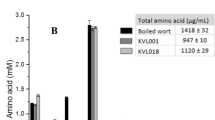Abstract
Wort containing deoxynivalenol and zearalenone, each added at a level of 1.9 μg/mL, was fermented by 3 strains ofSaccharomyces cerevisiae for 7 or 9 days to make beer. Analysis showed that deoxynivalenol was stable during this process. The major metabolite of zearalenone was β - zearalenol, which formed in up to 69% of the initial zearalenone concentration, while up to 8.1% of the initial zearalenone was converted to α - zearalenol. The major part of the metabolism of zearalenone occurred by 1 – 2 days. Control experiments, where the yeasts were omitted and deoxynivalenol, zearalenone and α - and β - zearalenol were added, showed good recovery and stability of the mycotoxins over the 7–9 day time period. No deoxynivalenol, zearalenone, α-zearalenol or β-zearalenol was detected in control yeast fermentations where they were not added to the wort.
Similar content being viewed by others
References
Scott PM (1990) Trichothecenes in grains. Cereal Foods World 35:661–666
Kuiper-Goodman T, Scott PM, Watanabe H (1987) Risk assessment of the mycotoxin zearalenone. Regul Toxicol Pharmacol 7: 253–306
Canales AM (1979) Unmalted grains in brewing.In: Pollock JRA (Ed) Brewing Science, Volume 1, Academic Press, London, pp 233–278
Flannigan B, Day SW, Douglas PE, McFarlane GB (1984) Growth of mycotoxin-producing fungi associated with malting of barley.In: Kurata H, Ueno Y (Eds) Toxigenic Fungi — Their Toxins and Health Hazard, Kodansha Ltd, Tokyo and Elsevier, Amsterdam, pp 52–60
Payen J, Girard T, Gaillardin M, Lafont P (1983) Sur la présence de mycotoxines dans des bières. Microbiol Alim Nutr 1:143–146
Trucksess MW, Flood MT, Page SW (1986) Thin layer chromatographic determination of deoxynivalenol in processed grain products. J Assoc Off Anal Chem 69:35 -36
Bata Á, Sarudi I, Ormai-Cserhalmi Z (1981) Zearalenone in beer. Acta Aliment 10:162–163
Vecchio A, Finoli C, Peccedi M, Cerutti G (1985) Sull’origine e la presenza di micotossine nella birra. Tecnol Aliment 8:84–87
Cerutti G, Vecchio A, Finoli C, Trezzi A (1987) Indices of quality for beer. Part 3: Mycotoxins. Monatsschr Brauwiss 40:455–4577
Lovelace CEA, Nyathi CB (1977) Estimation of the fungal toxins, zearalenone and aflatoxin, contaminating opaque maize beer in Zambia. J Sei Food Agric 28:288–292
Martin PMD, Keen P (1978) The occurrence of zearalenone in raw and fermented products from Swaziland and Lesotho. Sabouraudia 16:15–22
Okoye ZSC (1986) Zearalenone in native cereal beer brewed in Jos metropolis of Nigeria. J Food Safety 7:233–239
Whitehead MP, Flannigan B (1989) TheFusarium mycotoxin deoxynivalenol and yeast growth and fermentation. J Inst Brewing 95:411–4133
Matsuura Y, Yoshizawa T (1985) Conversion of zearalenone, an estrogenic mycotoxin, by brewing microorganisms. J Food Hyg Soc Japan 26:24–28
Sunjic V, Gelo M, Rusman S, DiGrazia L, Clauti G (1991) Stereoselective reduction of two zeranole precursors by Bakers’ yeast. Enzyme Microb Technol 13:344–348
Ueno Y, Tashiro F (1981) α - Zearalenol, a major hepatic metabolite in rats of zearalenone, an estrogenic mycotoxin ofFusarium species. J Biochem (Tokyo) 89:563–571
Hagler WM, Mirocha CJ, Pathre SV, Behrens JC (1979) Identification of the naturally occurring isomer of zearalenol produced byFusarium roseum “Gibbosum” in rice culture. Appl Environ Microbiol 37:849–853
Bennett GA, Lagoda AA, Shotwell OL, Hesseltine CW (1981) Utilization of zearalenone — contaminated corn for ethanol production. J Amer Oil Chem Soc 58:974–976
Okoye ZSC (1987) Stability of zearalenone in naturally contaminated corn during Nigerian traditional brewing. Food Addit Contam 4:57–59
Scott PM, Kanhere SR, Tarter EJ (1986) Determination of nivalenol and deoxynivalenol in cereals by electron — capture gas chromatography. J Assoc Off Anal Chem 69: 889–893
Health Protection Branch (1989) Determination of Nivalenol, Deoxynivalenol (Vomitoxin, DON), T-2 Toxin, HT-2 Toxin, 15 — Monoacetoxyscirpenol and Diacetoxyscirpenol in Wheat and Soybean by Gas Chromatography with Electron Capture Detection. Laboratory Procedure LPFC-155, 13 pp
Flannigan B, Morton JG, Naylor RJ (1985)Fusarium mycotoxins and the malting of barley.In: Lacey J (Ed) Trichothecenes and Other Mycotoxins, John Wiley & Sons, Chichester, UK, pp 171–184
Schwenk S, Altmayer B, Eichhorn KW (1989) Untersuchungen zur Bedeutung toxischer Stoffwechselprodukte des PilzesTrichothecium roseum Link ex Fr für den Weinbau. Z Lebensm Unters Forsch 188: 527–530
El-Banna AA (1987) Stability of citrinin and deoxynivalenol during germination process of barley. Mycotox Res 3:37–41
Palyusik M, Hagler WM, Horváth L, Mirocha CJ (1980) Biotransformation of zearalenone to zearalenol byCandida tropicalis. Acta Vet Acad Sei Hung 28:159–166
El-Sharkawy SH, Abul-Hajj YJ (1988) Microbial transformation of zearalenone. 2. Reduction, hydroxylation, and methylation products. J Org Chem 53:515–519
Kamimura K (1986) Conversion of zearalenone to zearalenone glycoside byRhizopus sp. Appl Environ Microbiol 52:515–519
El-Sharkawy S, Abul-Hajj Y (1987) Microbial transformation of zearalenone. I. Formation of zearalenone-4-O-β-glucoside. J Nat Prod 50: 520–521
El-Sharkawy S, Abul-Hajj YJ (1988) Microbial cleavage of zearalenone. Xenobiot 18:365 -371
El-Sharkawy SH (1989) Microbial transformation of zearalenone. III. Formation of 2, 4-O-β-diglucoside. Acta Pharm Jugosl 39:303–310
El-Sharkawy SH, Selim MI, Afifi MS, Halaweish FT (1991) Microbial transformation of zearalenone to a zearalenone sulfate. Appl Environ Microbiol 57: 549–552
Haikara A (1983) Malt and beer from barley artificially contaminated withFusarium in the field. Proc Eur Brew Conv Congr 19: 401–408
Author information
Authors and Affiliations
Rights and permissions
About this article
Cite this article
Scott, P.M., Kanhere, S.R., Daley, E.F. et al. Fermentation of wort containing deoxynivalenol and zearalenone. Mycotox Res 8, 58–66 (1992). https://doi.org/10.1007/BF03192217
Received:
Accepted:
Issue Date:
DOI: https://doi.org/10.1007/BF03192217




